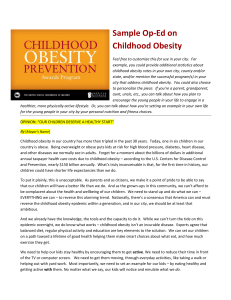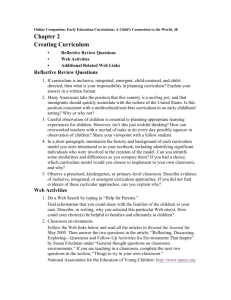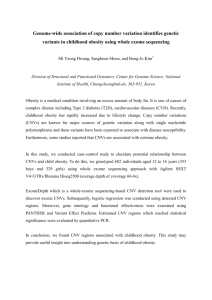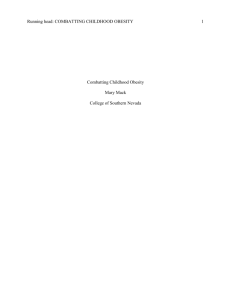Speech Student 2
advertisement
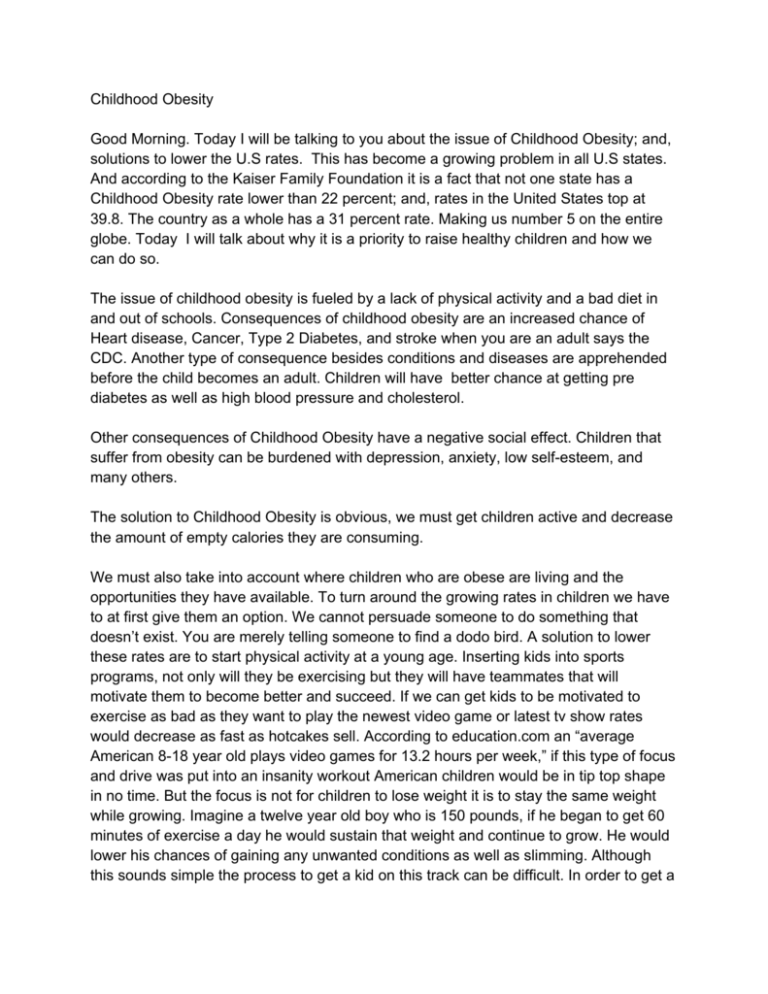
Childhood Obesity Good Morning. Today I will be talking to you about the issue of Childhood Obesity; and, solutions to lower the U.S rates. This has become a growing problem in all U.S states. And according to the Kaiser Family Foundation it is a fact that not one state has a Childhood Obesity rate lower than 22 percent; and, rates in the United States top at 39.8. The country as a whole has a 31 percent rate. Making us number 5 on the entire globe. Today I will talk about why it is a priority to raise healthy children and how we can do so. The issue of childhood obesity is fueled by a lack of physical activity and a bad diet in and out of schools. Consequences of childhood obesity are an increased chance of Heart disease, Cancer, Type 2 Diabetes, and stroke when you are an adult says the CDC. Another type of consequence besides conditions and diseases are apprehended before the child becomes an adult. Children will have better chance at getting pre diabetes as well as high blood pressure and cholesterol. Other consequences of Childhood Obesity have a negative social effect. Children that suffer from obesity can be burdened with depression, anxiety, low self-esteem, and many others. The solution to Childhood Obesity is obvious, we must get children active and decrease the amount of empty calories they are consuming. We must also take into account where children who are obese are living and the opportunities they have available. To turn around the growing rates in children we have to at first give them an option. We cannot persuade someone to do something that doesn’t exist. You are merely telling someone to find a dodo bird. A solution to lower these rates are to start physical activity at a young age. Inserting kids into sports programs, not only will they be exercising but they will have teammates that will motivate them to become better and succeed. If we can get kids to be motivated to exercise as bad as they want to play the newest video game or latest tv show rates would decrease as fast as hotcakes sell. According to education.com an “average American 8-18 year old plays video games for 13.2 hours per week,” if this type of focus and drive was put into an insanity workout American children would be in tip top shape in no time. But the focus is not for children to lose weight it is to stay the same weight while growing. Imagine a twelve year old boy who is 150 pounds, if he began to get 60 minutes of exercise a day he would sustain that weight and continue to grow. He would lower his chances of gaining any unwanted conditions as well as slimming. Although this sounds simple the process to get a kid on this track can be difficult. In order to get a kid engaged incentives are necessary; for example, for every 1 month a child sustains their weight they would get to do their favorite thing ever. Another option to sustaining weight over years is to start sending kids to recreation centers that have physical activity equipment.Those where only some solutions to solve the problem of the lack of physical education that will help stop the growth of childhood obesity. Another problem that is fueling childhood obesity is the easy access to unhealthy drinks and food. To stop the purchase of these things I propose that we implement a soda tax. A soda tax would decrease the purchase of these drinks with empty calories. I believe this and an increase in physical activity are the best solutions to regressing the problem. Think even if purchases of unhealthy drinks did not decrease, cities would still have more money to build safer community centers and parks for children to exercise. The Rudd Center for Food Policy and Obesity says that a soda tax in California alone would bring 1.1 billion dollars in revenue every year. That’s an extra 1.1 billion dollars to the state that can make the building of safer recreation centers more possible. I’m not saying that doing these things will be easy, but as a community if we work together to better our nation results will be present in no time. I will end by saying, unhealthy food isn’t becoming less easier to get to in our nation, therefore we must make the need and want for junk food unwanted and not a priority for our children Works Cited Bardi, Jason. “How Many Lives Could a Soda Tax Save.” UCSF.edu. 9 Jan. 2012. 1 December 2014 President’s Council on Fitness, Sports and Nutrition.Gov. of U.S.Web. 1 December 2014 Kff.org. The Henry J. Kaiser Family Foundation. 2 December 2014 Cdc.gov. Centers for Disease Control and Prevention. 13 August 2014. 2 December 2014 Education.com. N/A. 4 December 2014 Yaleruddcenter.org Rudd Center for Food Policy and Obesity

